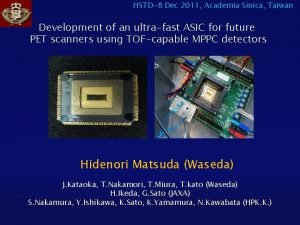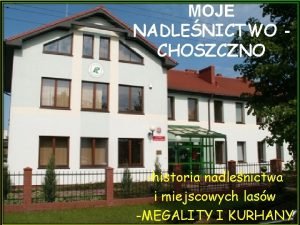Academia Sinica Research Center for Applied Sciences Ga

- Slides: 1

Academia Sinica Research Center for Applied Sciences Ga. N nanorods grown on Si (111) substrate by Plasma-Assisted Molecular Beam Epitaxy S. T. Chou 1, S. H. Tsai 1, M. Y. Lin 1, W. H. Liao 1, Shih-Yen Lin*, 1, 2, 1 Research Center for Applied Sciences, Academia Sinica, Nankang, Taipei, Taiwan 2 Department of Photonics, National Chiao-Tung University, Hsinchu, Taiwan *Tel. : +886 -3 -5744364, Fax:+886 -3 -5745233, e-mail:shihyen@gate. sinica. edu. tw I. Abstract 2. FE-SEM images The vertically c-axis aligned Ga. N nanorod arrays grown by plasma-assisted molecular-beam epitaxy are epitaxially oriented on Si(111) substrates without buffer layer and their crystal structure corresponds to a fully relaxed wurtzite lattice. At later growth stage, these Ga. N nanorods exhibit the tendency to coalesce into nanorod bundles. The Ga. N nanorods are demonstrated analyzed with FE-SEM, TEM, Micro-PL, and Micro-Raman techniques. Ga. N nanorods structures posses the advantages of strain-free and dislocation-free. Thus Ga. N nanorods are very promising material for device fabrication of high efficiency LEDs. II. Experiments Sample A (TS=780 ℃) Sample B Sample C Sample D Fig. 2 Cross-sectional and plan view FE-SEM images of the Ga. N nanostructures grown on Si (111) substrate without buffer layer. Sample C (TS=790 ℃) 500 nm n-Ga. N Sample D (TS=790 ℃) 500 nm n-Ga. N 1 nm Al. N 200 nm i-Ga. N 1300 nm n-Ga. N 200 nm i-Ga. N 1 nm Al. N 500 nm n-Ga. N 3. TEM images and SAD patterns (a) Growth direction Sample B (TS=790 ℃) Sample A Si (111) substrate Table. 1 The Ga. N nanorod structure and growth conditions of sample. A to D that grown on Si (111) substrates without buffer layer. (b) (10 -10) (0002) (0000) (000 -2) (-1010) Sample B <1 -210> zone axis Fig. 3 TEM image of a single free-standing Ga. N nanorod (a) The nanorod is nearly dislocation free. (b) A selected-area diffraction of the nanorod exhibits a wurtzite structure with elecctron beam along <1 -210> zone-axis. 4. The Micro-PL spectra III. Results and discussion 1. RHEED pattern a-plane [1 1 -2 0] Sample A m-plane [1 0 -1 0] Sample A Sample B Fig. 4 Room-temperature micro-PL spectrum for Ga. N nanorods. 5. The Micro-Raman spectra Sample C Sample D Fig. 1 Ga. N nanorod RHEED patterns of different plane, which correspond to the Ga. N surface morphologies. Fig. 5 Room-temperature micro-Raman spectra for Ga. N nanorods. Ga. N E 2(high) mode at 567 cm-1 also support that Ga. N nanorods are strain-free. IV. Conclusions In summary, we have confirmed that PAMBE-grown wurtzite Ga. N nanorods are completely relaxed, strain-free single crystals and they are epitaxially oriented on the Si (111) substrate. Both V/III ratio and substrate temperature play very important roles in the nanorods growth.

